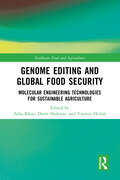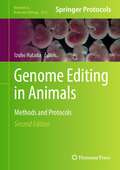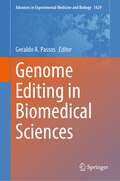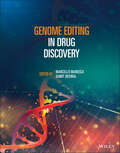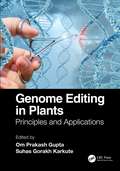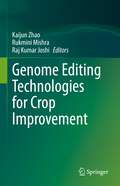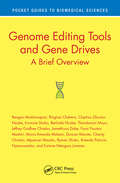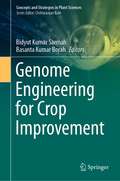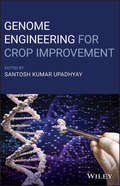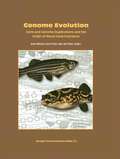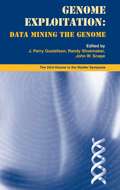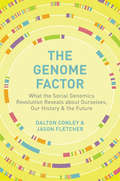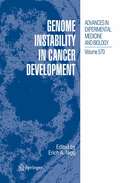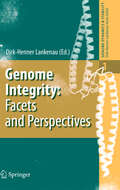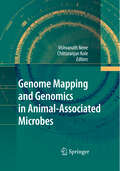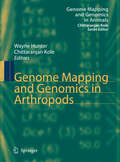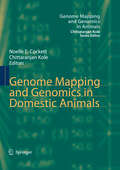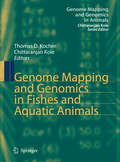- Table View
- List View
Genome Editing and Global Food Security: Molecular Engineering Technologies for Sustainable Agriculture (Earthscan Food and Agriculture)
by Zeba Khan Durre Shahwar Yasmin HeikalWith the rapid increase in the global population and changing climatic impacts on agriculture, this book demonstrates how genome editing will be an indispensable technique to overcome ongoing and prospective agricultural challenges. This book examines the role of genome editing in improving crop yields and contributing to global food security. It summarizes a range of genome editing techniques and discusses the roles they can play in producing a new generation of high-yielding, climate-ready crops. This includes site-specific nucleases, precision genome engineering, clustered regularly interspaced short palindromic repeats, and bioinformatics. It showcases how these gene editing techniques can tailor plants to not only increase yield-related traits but to also make them better suited to their environment and to be resistant to pests and extreme climatic events, such as droughts. The book also examines genome editing regulations and policies, the commercialization of genome-edited crops, and biosafety and biosecurity concerns. Overall, this book reveals and showcases how genome editing can improve crop resilience and production to address current and future agricultural challenges and alleviation of global food security concerns. This book will be of great interest to students and scholars of agricultural science, crop and plant science, genome editing, sustainable agriculture, biotechnology, and food security.
Genome Editing and Global Food Security: Molecular Engineering Technologies for Sustainable Agriculture (Earthscan Food and Agriculture)
With the rapid increase in the global population and changing climatic impacts on agriculture, this book demonstrates how genome editing will be an indispensable technique to overcome ongoing and prospective agricultural challenges. This book examines the role of genome editing in improving crop yields and contributing to global food security. It summarizes a range of genome editing techniques and discusses the roles they can play in producing a new generation of high-yielding, climate-ready crops. This includes site-specific nucleases, precision genome engineering, clustered regularly interspaced short palindromic repeats, and bioinformatics. It showcases how these gene editing techniques can tailor plants to not only increase yield-related traits but to also make them better suited to their environment and to be resistant to pests and extreme climatic events, such as droughts. The book also examines genome editing regulations and policies, the commercialization of genome-edited crops, and biosafety and biosecurity concerns. Overall, this book reveals and showcases how genome editing can improve crop resilience and production to address current and future agricultural challenges and alleviation of global food security concerns. This book will be of great interest to students and scholars of agricultural science, crop and plant science, genome editing, sustainable agriculture, biotechnology, and food security.
Genome Editing in Animals: Methods And Protocols (Methods In Molecular Biology Ser. #1630)
by Izuho HatadaGenome Editing in Biomedical Sciences (Advances in Experimental Medicine and Biology #1429)
by Geraldo A. PassosThis volume focuses on applying the Crispr system in editing the genome of human cells (in vitro and in vivo) and model organisms used in biomedical research. With the advent of Crispr technology, genome editing soon became a procedure of great interest to laboratories worldwide due to its relative ease and accuracy. In biomedical sciences, genome editing by Crispr has already enabled the development of new experimental model systems. In medicine, therapeutic alternatives for the genetic "correction" of diseases have already begun to appear. Therefore, the book's purpose is to bring in a single volume, chapters that show the scientific community in biomedicine, medicine, human genetics, oncology, virology, and parasitology, among others, the advances in genomic editing. In a chapter dedicated to the ethical aspects of human genomic editing, we also address what we can and should do with this (bio)technology. The book chapters were written by productive researchers specializing in Crispr genome editing. The chapters cover the concept of Crispr and genome editing and how to use this new methodology in biomedical research and medicine, among other aspects, including the ethical controversy around its use in humans. The writing of the chapters keeps a specialized language intelligible enough for those who want to introduce themselves to the subject.
Genome Editing in Cardiovascular and Metabolic Diseases (Advances in Experimental Medicine and Biology #1396)
by Junjie XiaoThis book provides the latest research progress on genome editing in cardiovascular and metabolic diseases and includes bioinformatics research methodology of genome editing. Genome editing is a genetic engineering technique precisely modified specific target genes of organism genome, which has been applied to basic theoretical research and production applications from plants and animals to gene therapy of human beings. Cardiovascular and metabolic diseases have become major factors affecting human health worldwide. This book contains information about bioinformatics, genome editing in cardiovascular diseases, genome editing in metabolic diseases and therapeutic effects. It will be useful for biologist, cardiologist, cardiovascular surgeons, endocrinologist, internists, nurses, undergraduate and graduate students in medicine and cell biology and others interested in cardiovascular and metabolic medicine.
Genome Editing in Drug Discovery
by Sumit Deswal Marcello MarescaGENOME EDITING IN DRUG DISCOVERY A practical guide for researchers and professionals applying genome editing techniques to drug discovery In Genome Editing in Drug Discovery, a team of distinguished biologists delivers a comprehensive exploration of genome editing in the drug discovery process, with coverage of the technology’s history, current issues and techniques, and future perspectives and research directions. The book discusses techniques for disease modeling, target identification with CRISPR, safety studies, therapeutic editing, and intellectual property issues. The safety and efficacy of drugs and new target discovery, as well as next-generation therapeutics are also presented. Offering practical suggestions for practitioners and academicians involved in drug discovery, Genome Editing in Drug Discovery is a fulsome treatment of a technology that has become part of nearly every early step in the drug discovery pipeline. Selected contributions also include: A thorough introduction to the applications of CRISPRi and CRISPRa in drug discovery Comprehensive explorations of genome-editing applications in stem cell engineering and regenerative medicine Practical discussions of the safety aspects of genome editing with respect to immunogenicity and the specificity of CRISPR-Cas9 gene editing In-depth examinations of critical socio-economic and bioethical challenges in the CRISPR-Cas9 patent landscape Perfect for academic researchers and professionals in the biotech and pharmaceutical industries, Genome Editing in Drug Discovery will also earn a place in the libraries of medicinal chemists, biochemists, and molecular biologists.
Genome Editing in Drug Discovery
by Marcello Maresca Sumit DeswalGENOME EDITING IN DRUG DISCOVERY A practical guide for researchers and professionals applying genome editing techniques to drug discovery In Genome Editing in Drug Discovery, a team of distinguished biologists delivers a comprehensive exploration of genome editing in the drug discovery process, with coverage of the technology’s history, current issues and techniques, and future perspectives and research directions. The book discusses techniques for disease modeling, target identification with CRISPR, safety studies, therapeutic editing, and intellectual property issues. The safety and efficacy of drugs and new target discovery, as well as next-generation therapeutics are also presented. Offering practical suggestions for practitioners and academicians involved in drug discovery, Genome Editing in Drug Discovery is a fulsome treatment of a technology that has become part of nearly every early step in the drug discovery pipeline. Selected contributions also include: A thorough introduction to the applications of CRISPRi and CRISPRa in drug discovery Comprehensive explorations of genome-editing applications in stem cell engineering and regenerative medicine Practical discussions of the safety aspects of genome editing with respect to immunogenicity and the specificity of CRISPR-Cas9 gene editing In-depth examinations of critical socio-economic and bioethical challenges in the CRISPR-Cas9 patent landscape Perfect for academic researchers and professionals in the biotech and pharmaceutical industries, Genome Editing in Drug Discovery will also earn a place in the libraries of medicinal chemists, biochemists, and molecular biologists.
Genome Editing in Plants: Principles and Applications
by Om Prakash Gupta Suhas Gorakh KarkuteGenome Editing in Plants: Principles and Applications addresses the information of genome editing starting from principles and historical aspects to the latest advancements in the field. As genome-editing technology has emerged as promising and cutting edge, researchers around the world have started producing original research outputs, which have significantly improved our current understanding and potential of this technology. The initial chapters of this book describe different genome-editing tools as well as their principles and applications. Other chapters are dedicated to the present status and future applications of genome-editing techniques in various crop improvement programmes. Some of the advanced applications of CRISPR/Cas tools, such as base editing and RNA detection, along with regulatory aspects of genome-edited crops are described in detail. This book serves as a valuable resource to researchers in the field of crop improvement; graduate and postgraduate students engaged in plant molecular biology and biotechnology; academicians; and policy makers. Key Features: Addresses topics associated with historical development and principles of genome-editing technology Addresses basic mechanisms operating under each genome-editing technology Addresses its application in plants to design crops as per the current and future demands Addresses the regulatory mechanisms of genome-edited crops
Genome Editing in Plants: Principles and Applications
by Om Prakash Gupta, Suhas Gorakh KarkuteGenome Editing in Plants: Principles and Applications addresses the information of genome editing starting from principles and historical aspects to the latest advancements in the field. As genome-editing technology has emerged as promising and cutting edge, researchers around the world have started producing original research outputs, which have significantly improved our current understanding and potential of this technology. The initial chapters of this book describe different genome-editing tools as well as their principles and applications. Other chapters are dedicated to the present status and future applications of genome-editing techniques in various crop improvement programmes. Some of the advanced applications of CRISPR/Cas tools, such as base editing and RNA detection, along with regulatory aspects of genome-edited crops are described in detail. This book serves as a valuable resource to researchers in the field of crop improvement; graduate and postgraduate students engaged in plant molecular biology and biotechnology; academicians; and policy makers. Key Features: Addresses topics associated with historical development and principles of genome-editing technology Addresses basic mechanisms operating under each genome-editing technology Addresses its application in plants to design crops as per the current and future demands Addresses the regulatory mechanisms of genome-edited crops
Genome Editing Technologies for Crop Improvement
by Kaijun Zhao Rukmini Mishra Raj Kumar JoshiThis book compiles the relevant information related to genome editing tools and their roles in crop improvement. The book contains a brief introduction about various genome editing tools and their application in major crops. It discusses the genome editing approaches and the strategies used for genome editing in different crops. Some of the chapters cover the detailed methodology of sgRNA design, vector construction and transformation in different crops followed by data analysis. A few chapters focus on the applications of genome editing tools towards crop improvement. This book will be of particular interest to plant biologists working in the field of genome editing and crop breeders. It will provide valuable information and useful material for our readers’ experimental work.
Genome Editing Tools and Gene Drives: A Brief Overview (Pocket Guides to Biomedical Sciences)
by Reagan Mudziwapasi Ringisai Chekera Clophas Zibusiso Ncube Irvonnie Shoko Berlinda Ncube Thandanani Moyo Jeffrey Godfrey Chimbo Jemethious Dube Farai Faustos Mashiri Moira Amanda Mubani Duncan Maruta Charity Chimbo Mpumuzi Masuku Ryman Shoko Rutendo Patricia Nyamusamba Fortune Ntengwa JomaneGenome-editing methods are becoming routine tools for molecular and cell biologists. Such tools include ZFNs, CRISPR, megaTALs and TALENs. These tools are revolutionizing the creation of precisely manipulated genomes to modify the characteristics of organisms or cells. Additionally, gene drives have altered the way we understand inheritance laws. They give us the ability to have total control of the inheritance of traits of choice and importance. This succinct volume summarizes the history, principles and applications – as well as the advantages and disadvantages – of each of these tools and various kinds of gene drives. The book is part of a program to produce books helpful to students and faculties of science at colleges and universities. This volume in the Pocket Guides to Biomedical Sciences series will help demystify these technologies. The book fills the gap between established conventional methods and the novel and exciting newly introduced tools of genome editing and gene drives. It will help young scientists understand the emerging genome-editing tools and gene drives, thereby promoting related research and adoption. Key Features Extensively reviews the current genome-editing tools and gene drives Clarifies the targeting mechanisms and specificity of genome-editing tools Details many different types of natural and synthetic gene drives Highlights concerns with gene drives and genome-editing tools Related Titles Brown, T. A. Genomes 4 (ISBN 978-0-8153-4508-4) Samuelsson, T. The Human Genome in Health and Disease: A Story in Four Letters (ISBN 978-0-8153-4591-6) Soh, J., et al. Genome Annotation (ISBN 978-1-4398-4117-4)
Genome Editing Tools and Gene Drives: A Brief Overview (Pocket Guides to Biomedical Sciences)
by Reagan Mudziwapasi Ringisai Chekera Clophas Zibusiso Ncube Irvonnie Shoko Berlinda Ncube Thandanani Moyo Jeffrey Godfrey Chimbo Jemethious Dube Farai Faustos Mashiri Moira Amanda Mubani Duncan Maruta Charity Chimbo Mpumuzi Masuku Ryman Shoko Rutendo Patricia Nyamusamba Fortune Ntengwa JomaneGenome-editing methods are becoming routine tools for molecular and cell biologists. Such tools include ZFNs, CRISPR, megaTALs and TALENs. These tools are revolutionizing the creation of precisely manipulated genomes to modify the characteristics of organisms or cells. Additionally, gene drives have altered the way we understand inheritance laws. They give us the ability to have total control of the inheritance of traits of choice and importance. This succinct volume summarizes the history, principles and applications – as well as the advantages and disadvantages – of each of these tools and various kinds of gene drives. The book is part of a program to produce books helpful to students and faculties of science at colleges and universities. This volume in the Pocket Guides to Biomedical Sciences series will help demystify these technologies. The book fills the gap between established conventional methods and the novel and exciting newly introduced tools of genome editing and gene drives. It will help young scientists understand the emerging genome-editing tools and gene drives, thereby promoting related research and adoption. Key Features Extensively reviews the current genome-editing tools and gene drives Clarifies the targeting mechanisms and specificity of genome-editing tools Details many different types of natural and synthetic gene drives Highlights concerns with gene drives and genome-editing tools Related Titles Brown, T. A. Genomes 4 (ISBN 978-0-8153-4508-4) Samuelsson, T. The Human Genome in Health and Disease: A Story in Four Letters (ISBN 978-0-8153-4591-6) Soh, J., et al. Genome Annotation (ISBN 978-1-4398-4117-4)
Genome Engineering for Crop Improvement (Concepts and Strategies in Plant Sciences)
by Bidyut Kumar Sarmah Basanta Kumar BorahThis book serves the teachers, researchers and the students as a handy and concise reference as well as guidebook while designing and planning for use of the advanced technologies for crop improvement.The content of the book is designed to cover the latest genome engineering techniques for crop improvement. The conventional breeding has got its limitations such as non-availability of desired genes within the genepool. In many cases, breeding has been highly used and it has nearly reached its highest limit so far as the productivity and production of crops are concerned. However, with increasing need of food and decreasing resources, including water, land, labour, etc., to feed the growing population, the alternative available ways of increasing crop productivity need to be explored and exploited. Genome engineering has a wide scope that includes technologies such as genetic engineering and transgenesis, RNA technologies, CRISPR, cisgenics and subgenics for better productivity and more efficient biotic and abiotic stress management. Therefore, the book is planned to enlighten the readers with the advanced technologies with examples and case studies, whenever possible. Efforts will be made to emphasize on general efforts on various major food crops; however, it would also be made clear that such efforts could be taken as proofs of concepts and that this could be extrapolated keeping the demand in mind.
Genome Engineering for Crop Improvement
by Santosh UpadhyayIn recent years, significant advancements have been made in the management of nutritional deficiency using genome engineering—enriching the nutritional properties of agricultural and horticultural crop plants such as wheat, rice, potatoes, grapes, and bananas. To meet the demands of the rapidly growing world population, researchers are developing a range of new genome engineering tools and strategies, from increasing the nutraceuticals in cereals and fruits, to decreasing the anti-nutrients in crop plants to improve the bioavailability of minerals and vitamins. Genome Engineering for Crop Improvement provides an up-to-date view of the use of genome editing for crop bio-fortification, improved bioavailability of minerals and nutrients, and enhanced hypo-allergenicity and hypo-immunogenicity. This volume examines a diversity of important topics including mineral and nutrient localization, metabolic engineering of carotenoids and flavonoids, genome engineering of zero calorie potatoes and allergen-free grains, engineering for stress resistance in crop plants, and more. Helping readers deepen their knowledge of the application of genome engineering in crop improvement, this book: Presents genetic engineering methods for developing edible oil crops, mineral translocation in grains, increased flavonoids in tomatoes, and cereals with enriched iron bioavailability Describes current genome engineering methods and the distribution of nutritional and mineral composition in important crop plants Offers perspectives on emerging technologies and the future of genome engineering in agriculture Genome Engineering for Crop Improvement is an essential resource for academics, scientists, researchers, agriculturalists, and students of plant molecular biology, system biology, plant biotechnology, and functional genomics.
Genome Engineering for Crop Improvement
by Santosh Kumar UpadhyayIn recent years, significant advancements have been made in the management of nutritional deficiency using genome engineering—enriching the nutritional properties of agricultural and horticultural crop plants such as wheat, rice, potatoes, grapes, and bananas. To meet the demands of the rapidly growing world population, researchers are developing a range of new genome engineering tools and strategies, from increasing the nutraceuticals in cereals and fruits, to decreasing the anti-nutrients in crop plants to improve the bioavailability of minerals and vitamins. Genome Engineering for Crop Improvement provides an up-to-date view of the use of genome editing for crop bio-fortification, improved bioavailability of minerals and nutrients, and enhanced hypo-allergenicity and hypo-immunogenicity. This volume examines a diversity of important topics including mineral and nutrient localization, metabolic engineering of carotenoids and flavonoids, genome engineering of zero calorie potatoes and allergen-free grains, engineering for stress resistance in crop plants, and more. Helping readers deepen their knowledge of the application of genome engineering in crop improvement, this book: Presents genetic engineering methods for developing edible oil crops, mineral translocation in grains, increased flavonoids in tomatoes, and cereals with enriched iron bioavailability Describes current genome engineering methods and the distribution of nutritional and mineral composition in important crop plants Offers perspectives on emerging technologies and the future of genome engineering in agriculture Genome Engineering for Crop Improvement is an essential resource for academics, scientists, researchers, agriculturalists, and students of plant molecular biology, system biology, plant biotechnology, and functional genomics.
Genome Evolution: Gene and Genome Duplications and the Origin of Novel Gene Functions
by Axel Meyer Yves Van De PeerIn the years since the publication of Susumu Ohno's 1970 landmark book Evolution by gene duplication tremendous advances have been made in molecular biology and especially in genomics. Studies of genome structure and function prerequisite to testing hypotheses of genome evolution were all but impossible until recent methodological advances. This book evaluates newly generated empirical evidence as it pertains to theories of genomic evolutionary patterns and processes. Tests of hypotheses using analyses of complete genomes, interpreted in a phylogenetic context, provide evidence regarding the relative importance of gene duplication. The alternative explanation is that the evolution of regulatory elements that control the expression of and interactions among genes has been a more important force in shaping evolutionary innovation. This collection of papers will be of interest to all academic and industry researchers working in the fields of molecular biology, biotechnology, genomics and genome centers.
Genome Exploitation: Data Mining the Genome (Stadler Genetics Symposia Series)
by J. Perry Gustafson Randy Shoemaker John W. SnapeGenome Exploitation: Data Mining the Genome is developed from the 23rd Stadler Genetic Symposium. This volume discusses and illustrates how scientists are going to characterize and make use of the massive amount of information being accumulated about the plant and animal genomes. Genome Exploitation: Data Mining the Genome is a state-of-the-art picture on mining the Genome databases. This is one of the few times that researchers in both plants and animals will be working together to create a seminal data resource.
The Genome Factor: What the Social Genomics Revolution Reveals about Ourselves, Our History, and the Future
by Dalton Conley Jason FletcherFor a century, social scientists have avoided genetics like the plague. But the nature-nurture wars are over. In the past decade, a small but intrepid group of economists, political scientists, and sociologists have harnessed the genomics revolution to paint a more complete picture of human social life than ever before. The Genome Factor describes the latest astonishing discoveries being made at the scientific frontier where genomics and the social sciences intersect.The Genome Factor reveals that there are real genetic differences by racial ancestry—but ones that don't conform to what we call black, white, or Latino. Genes explain a significant share of who gets ahead in society and who does not, but instead of giving rise to a genotocracy, genes often act as engines of mobility that counter social disadvantage. An increasing number of us are marrying partners with similar education levels as ourselves, but genetically speaking, humans are mixing it up more than ever before with respect to mating and reproduction. These are just a few of the many findings presented in this illuminating and entertaining book, which also tackles controversial topics such as genetically personalized education and the future of reproduction in a world where more and more of us are taking advantage of cheap genotyping services like 23andMe to find out what our genes may hold in store for ourselves and our children.The Genome Factor shows how genomics is transforming the social sciences—and how social scientists are integrating both nature and nurture into a unified, comprehensive understanding of human behavior at both the individual and society-wide levels.
The Genome Factor: What the Social Genomics Revolution Reveals about Ourselves, Our History, and the Future
by Dalton Conley Jason FletcherFor a century, social scientists have avoided genetics like the plague. But the nature-nurture wars are over. In the past decade, a small but intrepid group of economists, political scientists, and sociologists have harnessed the genomics revolution to paint a more complete picture of human social life than ever before. The Genome Factor describes the latest astonishing discoveries being made at the scientific frontier where genomics and the social sciences intersect.The Genome Factor reveals that there are real genetic differences by racial ancestry—but ones that don't conform to what we call black, white, or Latino. Genes explain a significant share of who gets ahead in society and who does not, but instead of giving rise to a genotocracy, genes often act as engines of mobility that counter social disadvantage. An increasing number of us are marrying partners with similar education levels as ourselves, but genetically speaking, humans are mixing it up more than ever before with respect to mating and reproduction. These are just a few of the many findings presented in this illuminating and entertaining book, which also tackles controversial topics such as genetically personalized education and the future of reproduction in a world where more and more of us are taking advantage of cheap genotyping services like 23andMe to find out what our genes may hold in store for ourselves and our children.The Genome Factor shows how genomics is transforming the social sciences—and how social scientists are integrating both nature and nurture into a unified, comprehensive understanding of human behavior at both the individual and society-wide levels.
Genome Instability in Cancer Development (Advances in Experimental Medicine and Biology #570)
by Erich A. NiggResearch over the past decades has firmly established the genetic basis of cancer. In particular, studies on animal tumour viruses and chromosome rearrangements in human tumours have concurred to identify so-called ‘proto-oncogenes’ and ‘tumour suppressor genes’, whose deregulation promotes carcinogenesis. These important findings not only explain the occurrence of certain hereditary tumours, but they also set the stage for the development of anti-cancer drugs that specifically target activated oncogenes. However, in spite of tremendous progress towards the elucidation of key signalling pathways involved in carcinogenesis, most cancers continue to elude currently available therapies. This stands as a reminder that “cancer” is an extraordinarily complex disease: although some cancers of the haematopoietic system show only a limited number of characteristic chromosomal aberrations, most solid tumours display a myriad of genetic changes and considerable genetic heterogeneity. This is thought to reflect a trait commonly referred to as ‘genome instability’, so that no two cancers are ever likely to display the exact same genetic alterations. Numerical and structural chromosome aberrations were recognised as a hallmark of human tumours for more than a century. Yet, the causes and consequences of these aberrations still remain to be fully understood. In particular, the question of how genome instability impacts on the development of human cancers continues to evoke intense debate.
Genome Integrity: Facets and Perspectives (Genome Dynamics and Stability #1)
by Dirk-Henner LankenauThis is the first book to give a full overview on genome integrity in different species. From microorganisms to humans, this volume provides an interdisciplinary overview of how genome integrity is maintained. Written by an international panel of experts, the book addresses the connection between genome integrity and human disease.
Genome Mapping and Genomics in Animal-Associated Microbes
by Vishvanath Nene Chittaranjan KoleAchievements and progress in genome mapping and the genomics of microbes supersede by far those for higher plants and animals, in part due to their enormous economic implication but also smaller genome size. In the post-genomic era, whole genome sequences of animal-associated microbes are providing clues to depicting the genetic basis of the complex host-pathogen relationships and the evolution of parasitism; and to improving methods of controlling pathogens. This volume focuses on a globally important group of intracellular prokaryotic pathogens which affect livestock animals. These include Brucella, Mycobacterium, Anaplasma and Ehrlichia, as well as the protozoan pathogens Cryptosporidium and Theileria, for which genome sequence data is available. Insights from comparative genomics of the microbes described provide clues to the adaptation involved in host-microbe interactions, as well as resources potentially useful for application in future research and product development.
Genome Mapping and Genomics in Arthropods (Genome Mapping and Genomics in Animals #1)
by Wayne Hunter Chittaranjan KoleThe series "Genome Mapping and Genomics in Animals" provides comprehensive and up-to-date reviews on genomic research on a large variety of selected animal systems, contributed by leading scientists from around the world. The huge amount of information hitherto dispersed in journals is now available in this clearly structured reference work. Arthropods covered here include honeybee, bumblebee, the parasitic Jewel Wasp, silkworm, pea aphid, mosquito, Hessian fly and tick.
Genome Mapping and Genomics in Domestic Animals (Genome Mapping and Genomics in Animals #3)
by Noelle E. Cockett Chittaranjan KoleGenomics research on animals has generated huge databases and several new concepts and strategies, which are used to elucidate origin, evolution and phylogeny of species. Genetic and physical maps of genomes give details on chromosomal location, function, expression and regulation of genes. The series Genome Mapping and Genomics in Animals provides comprehensive and up-to-date reviews on genomic research on selected animal systems contributed by leading scientists from around the world. This volume offers information on gene mapping and genomics research in domesticated and farmed animals including cattle, water buffalo, sheep, deer, poultry, turkeys, rabbits, dogs and pigs. While the genome maps for some species are very limited, full genome sequences are available for cattle, chickens and dogs. Genomic research contributes to the identification of genetic regions that control the functionality and well-being of animals. Several farmed species are also used as models for biomedical studies.
Genome Mapping and Genomics in Fishes and Aquatic Animals (Genome Mapping and Genomics in Animals #2)
by Thomas D. Kocher Chittaranjan KoleMapping of animal genomes has generated huge databases and several new concepts and strategies, which are useful to elucidate origin, evolution and phylogeny. Genetic and physical maps of genomes further provide precise details on chromosomal location, function, expression and regulation of academically and economically important genes. The series Genome Mapping and Genomics in Animals provides comprehensive and up-to-date reviews on genomic research on a large variety of selected animal systems, contributed by leading scientists from around the world. This volume summarizes the first era of genomic studies of aquaculture species, in which the tools and resources necessary to support whole-genome sequencing were developed. These tools will enhance efforts toward selective breeding of aquaculture species. Included in this volume are summaries of work on salmonids, cyprinids, catfish, tilapias, European sea bass, Japanese flounder, shrimps and oysters.
